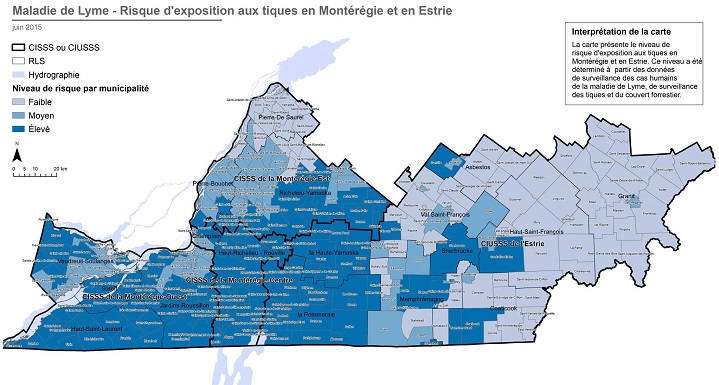MONTREAL – Health authorities have expanded the zone in which Montérégie residents are at risk of catching Lyme disease.

Rigaud, Hudson, Saint-Lazare, Île-Perrot, Hinchinbrooke, Châteauguay and Longueuil are now all high-risk areas for the disease, which is carried by ticks.
Other areas such as Vaudreuil-Dorion, Saint-Zotique, Brossard and Pincourt are considered medium risk, according to Santé Montérégie.
Lyme disease is passed to people by ticks that latch onto human hosts and suck their blood for up to three days at a time, leading to infection.
The symptoms are a mixed bag and can be confused with other problems like colds or flu – watch out for fever, fatigue muscle soreness and large, painless red patches on the skin.
It can take several weeks for symptoms to show up, but it’s important to see a doctor if you have them as Lyme Disease can be treated with antibiotics.
Since ticks live mostly in forests, tall grass and wooded areas, it’s unlikely that anyone could contract Lyme in urban or built-up suburban areas.
READ MORE: Lyme disease grows increasingly common in Quebec
But if you’re planning anything outdoorsy, it would be wise to take some precautions.
“We tell people to stay on the tracks and to cover their skin,” Dr. Patricia Hudson of Santé Montérégie previously told Global News.
That means long pants, long sleeves and closed-toed shoes; insect repellent can also help keep ticks away.
“When people go home, they should shower, then inspect their body to recognize the tick bite,” Hudson also advised.
If you do find a tick on you, make sure to remove it quickly – a tick generally needs to leech blood from a person for over 24 hours before Lyme disease can be passed on.
Cases of Lyme disease have spiked quickly since the illness first appeared in Quebec in 2008.
Just a handful of cases showed up in the first few years, but well over 100 reports have surfaced over the last couple of summers.
The majority of those cases were in the Montérégie region, but parts of Estrie and Mauricie-Centre-du-Quebec have also spawned multiple Lyme infections.
While Lyme used to be found primarily in the United States, climate change has helped to push it further north over the Canadian border, and it continues to creep north by a few kilometres each year.




Comments